Early C&S Water Tank Paint Schemes
12



















12
Early C&S Water Tank Paint Schemes
|
This post was updated on .
Conventional wisdom has it, that between 1905 and 1910, the C&S B&B gangs began repainting the new company's depots. The old red Union Pacific paint jobs were replaced with a new paint scheme of a light gray with either dark or Pullman green. The only written documentation of the colors of this light with dark trim scheme, of which I am aware, is a quote in the Lingers' Platte Canon Memories . . . that a December 11, 1908 newspaper article noted that the Como depot and dispatcher's office/library were painted a "harmonious gray and green".
The recent restoration of the Como depot pays homage to this gray and green scheme (all August 8, 2015): 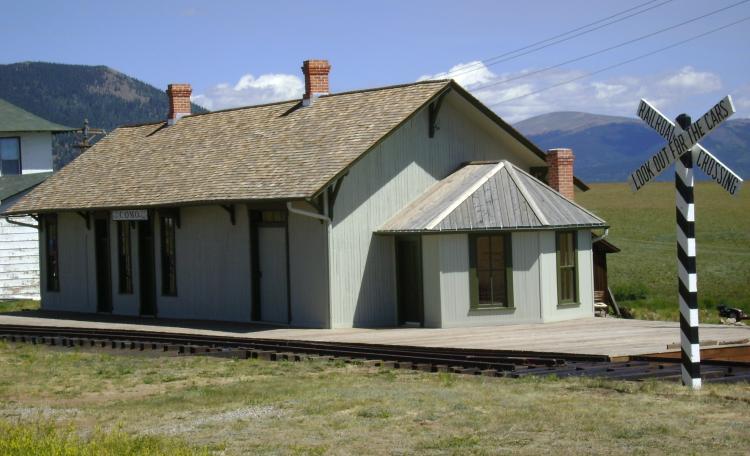   Anyways, the point of this post is the use of this scheme on C&S water tanks along the narrow gauge. I'd just recently been fiddling with the 1910 Common Standards water tank drawings and just read Todd Furguson's "Forks Creek Water Tank" thread. This particular picture and it's enlargements, from the other Forks Creek thread, got me to consider how the 1910 water tanks might have been painted:  Not only were the depot and eating house at Forks apparently painted in gray and green, but so were the section house beyond the bridge and the water tank and pump house as well:   (Chris Walker enlargement) If the water tank's tub body is gray, are the contrasting bands, as well as the spout scaffold and support post/braces, all green? If so, that would be one colorful water tank for a Colorado narrow gauge railroad!! Take that D&RGW yellow and brown! I began to wonder if this was a system wide convention of the era: In addition to the depots, were other railroad structures painted gray and green? I remember photos of almost all depots in the grey/green scheme, but only remember a few photos of tanks in the light scheme with dark trim, and none of Como or west or south of that point. Then it dawned on me, perhaps the B&B department invested time and money on non-depot railroad structures only at stations along the mainlines that saw a lot of summer excursion traffic. You know, spiff up the property to impress the tourists. That would mean the Clear Creek line up to the Loop and Silver Plume and the Platte Canyon line up to the two C&S owned lodges at Baileys and Shawnee, possibly up to Grant where the Fish Train turned. Clear Creek Line: To test this theory I went through all my books and photos, looking for Clear Creek water tanks. No luck with light/dark trim tanks at Elk Creek or Georgetown. Update 9/03/15--Chris Walker kindly lead me to links and his own copies of photos at Idaho Springs. See his full post and comments below. I have cropped two photos to show essentially the same scene in West Idaho Springs, of the water tank, section house and tool house: The first is dated to about 1903 ("The Colorado Road" herald on coal car) and shows the structures in their UPD&G solid red scheme. 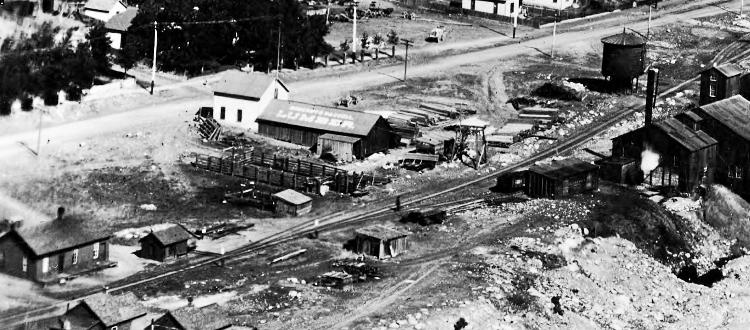 Chris Walker link to DPL: http://digital.denverlibrary.org/cdm/fullbrowser/collection/p15330coll22/id/3381/rv/singleitem/rec/14 The second is sometime after 1907 (boxcar with C&S block monogram out of frame to right), and shows the same structures in the light with dark trim scheme, presumably light gray and green. 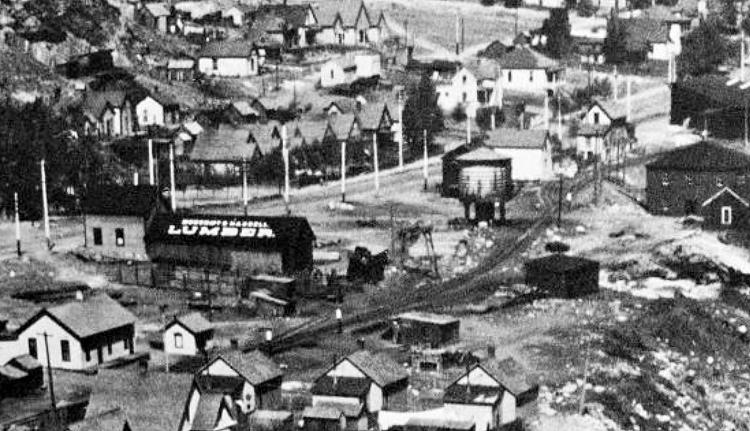 Chris Walker photo from Mineral Belt III, page 314. In another photo posted by Chris, the Idaho Springs depot in the light and dark trim scheme is visible: 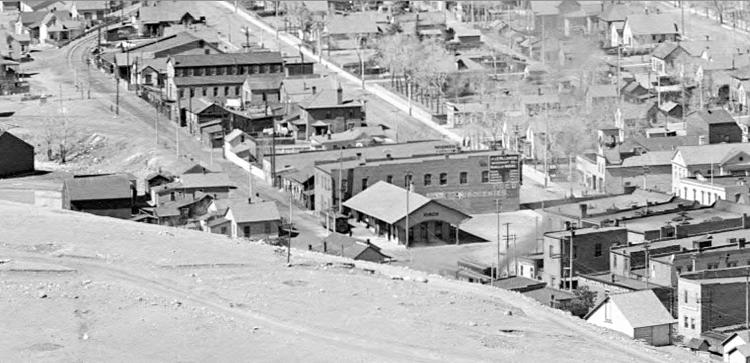 http://digital.denverlibrary.org/cdm/fullbrowser/collection/p15330coll22/id/1428/rv/singleitem/rec/24 Silver Plume had a 30,000 gallon flat roofed tank, painted in a dark color during UPD&G days, but was removed prior to the C&S incorporation. The depot received the light scheme with dark trim by 1912-13 . . .  . . . as did the tool shed to the west of the depot. The water tank was located this side of the tool shed, between the mainline and the 3-way stub switch on the house track. Both the depot outhouses still seem to be a dark color.  Both photos from "Colorado Central Railroad", Abbott et al, 2007, pages 393 and 396. Perhaps other Clear Creek authorities at this site can supply any other photos they may have. Platte Canyon: An exploration of Platte Canyon was more satisfying, suggesting the theory might be correct. McClure shot many publicity photos along the line for the C&S in 1909-1910, so there is more to find. I don't know of any first decade photos of the Waterton tank, but next up along the line was Dome Rock where many a flat land excursionist went picnicking: 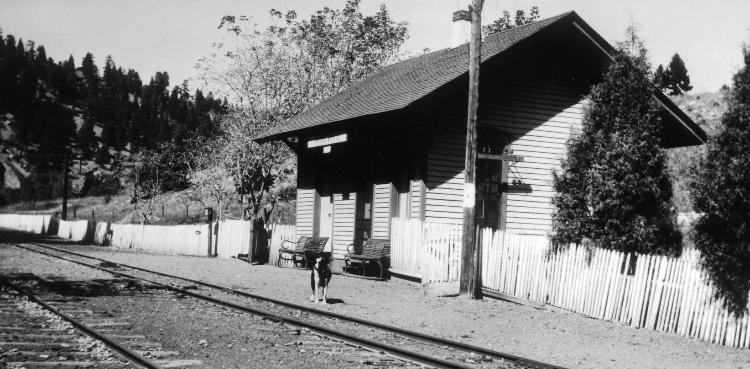 http://cdm16079.contentdm.oclc.org/cdm/singleitem/collection/p15330coll22/id/5628/rec/19 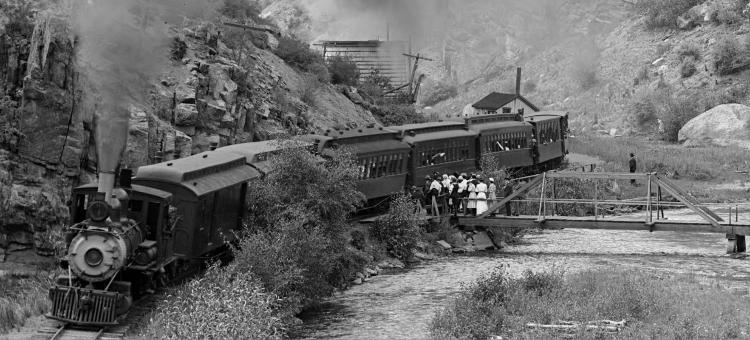 http://cdm16079.contentdm.oclc.org/cdm/singleitem/collection/p15330coll22/id/38231/rec/6 In addition to the little depot, both the big 50,000 gallon tank and the pump house are painted in a light with dark trim scheme, just like Forks Creek. The tank has contrasting dark bands, could they really be green??  Next tank west was Riverview. The tank (30,000 gallon) was a dark color at the time of the famous wreck in April 1902, but later it was light colored with contrasting bands: 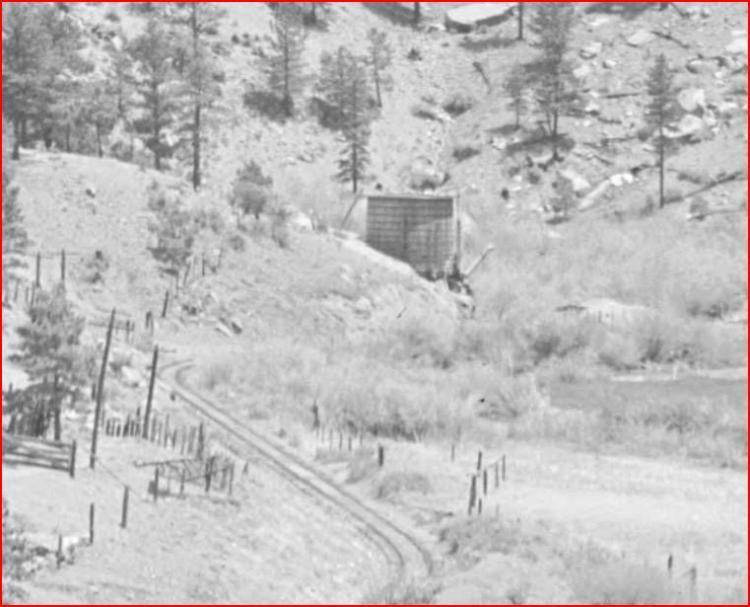 (Another Chris Walker enlargement of a DPL photo)http://digital.denverlibrary.org/cdm/singleitem/collection/p15330coll22/id/78053/rec/1657 A bit further west, the big 2 story section house at the east end of Buffalo siding was painted gray and green:  George Diary, DPL from Klingers' Platte Canyon Memories . . ., page 106 As was the Buffalo depot and its attached outside waiting room (far end of depot):  The depot at Pine Grove was gray and green, but the next water tank was at Crossons, a 30,000 gallon tank, at the east end of Estabrook canyon. Perhaps a bit later in time, the tub is fairly weathered, but again the bands are contrasting and the support posts and frame appear to be painted not weathered, unpainted wood: 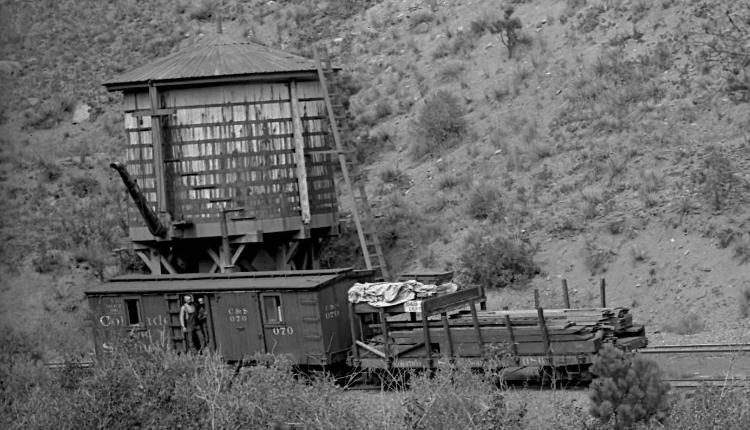 http://digital.denverlibrary.org/cdm/fullbrowser/collection/p15330coll22/id/78391/rv/singleitem At the west end of Estabrook canyon, the little depot at the station of the same name in gray/green: 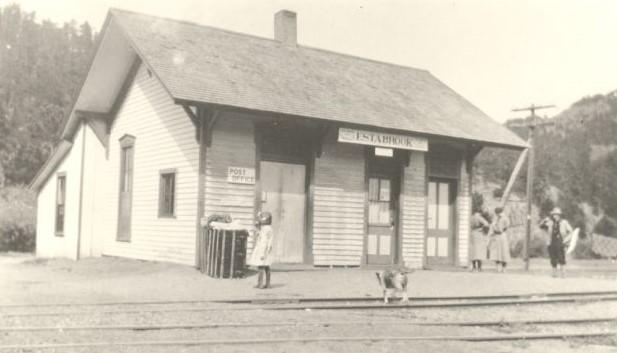 Park County Historical Society At Baileys, the depot and pump house are gray and green and up at the Kiowa Lodge there is a similarly painted water tank:  http://digital.denverlibrary.org/cdm/fullbrowser/collection/p15330coll22/id/243/rv/singleitem/rec/5 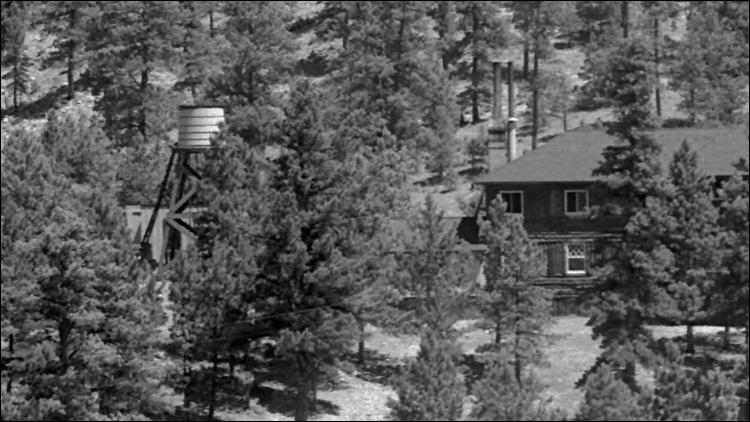 (Another Chris Walker enlargement of the above DPL photo) A color view of the depot interior might suggest the exterior scheme:  Park County Historical Society: Bailey Depot. 1971. Ticket office looking into passenger waiting room (south). Credit: Clifford A. Mestel The next water tank is at Shawnee. I swear I've seen an early photo of the Shawnee tank, but I can't seem to find it, and can't recall its color. The rustic log depot at Shawnee, was never painted, except for the lower part of the chimney: 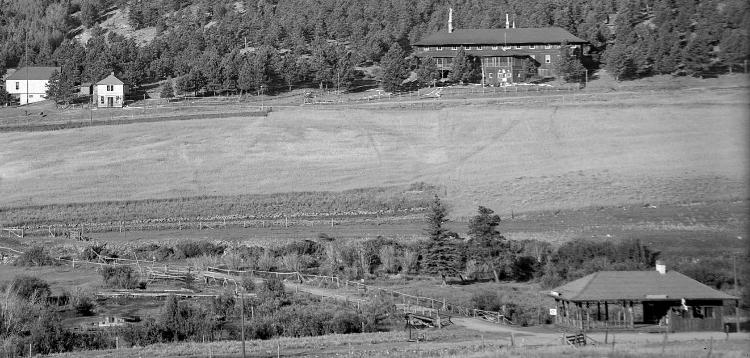 <a href="http://">http://digital.denverlibrary.org/cdm/singleitem/collection/p15330coll22/id/306/rec/500 I was able to find a companion water tank at the Shawnee Lodge to the one at the Kiowa Lodge, but it wasn't painted:  Above Shawnee was Grant, where the Fish Trains turned and spent the night. Both the depot/telegraph office and the little detached freight house were in the gray/green scheme by 1913 and a bit of rustic railing has been installed around the depot area: 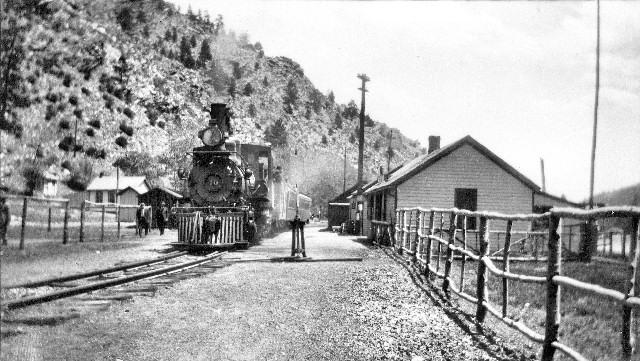 Circa 1913, Park County Historical Society 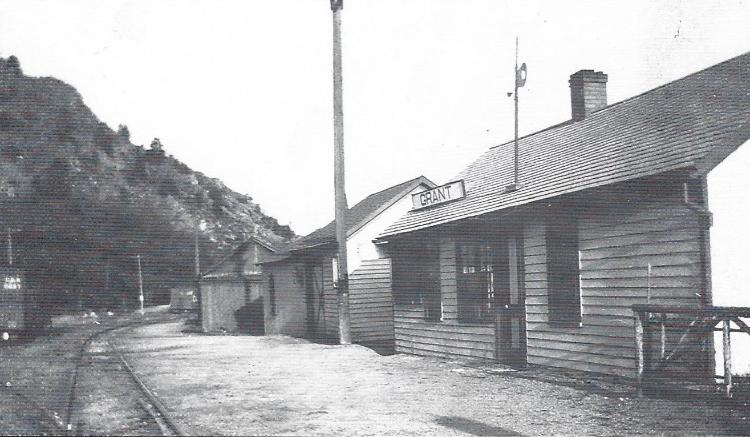 Carl Reich photo, 1913. In the Klingers' "Platte Canon Memories . . .", page 180. Finally, there is the water tank at Webster. The only early photo that I can find of the tank, shows it to be painted in a dark color, heavily weathered: 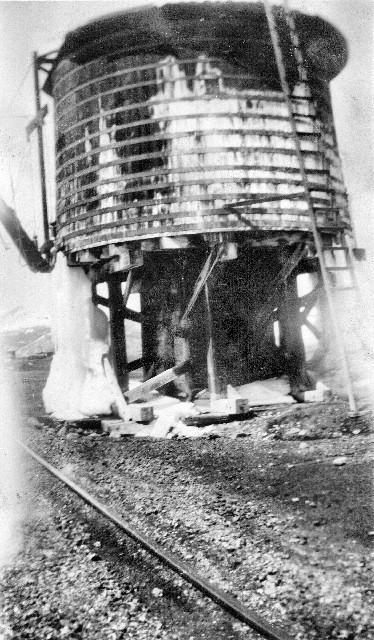 Park County Historical Society And that's it--from Webster west to Leadville and South to Gunnison, I can find no photo of a water tank (or any structure other than depots) painted in the light with dark scheme. Perhaps management felt that the passengers on the Leadville train or the Alma or Gunnison mixed trains didn't need to be impressed. If anyone has other photos of light water tanks, please add them here. Finally, a couple of questions: Do any of you paper collecting historians, like Rick or Doug or Derrell, have any written records of early C&S structure painting specifications? I am assuming the water tanks, section houses, pump housed were painted gray and green--is there written evidence to the contrary? How did the Forks Creek tank end up buff and red/brown in the last years? Can any of the wonderful people restoring the Como depot tell me if the restoration paint job is matched to actual paint samples found on the depot?
Jim Courtney
Poulsbo, WA |
Re: Early C&S Water Tank Paint Schemes
|
Excellent work, Jim. A couple of data points to add:
Near the end of operations the Jefferson depot was light/dark (presumably gray/green), but the water tank and pump house were dark/dark:  There’s a painting by Otto Kuhler of the Jefferson depot and water tank with both of them buff/brown, and eye-witness accounts give the Jefferson depot as buff/brown in the 60’s: 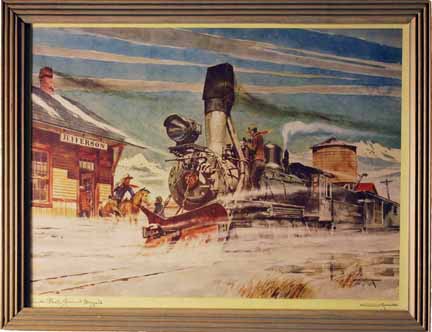 So, something to do with the Forks colour scheme? Otto taking artistic license? Some later restorer of the depot then taking Otto at face value? Who knows (although I suspect Otto was beautifying his picture, given that while the depot may have been buff/brown, we know the water tank wasn't). Kokomo also supports your theory: gray/green depot with 2 dark/dark (presumably boxcar red) car body storage sheds and a dark/dark handcar shed. I’ve done a similar exercise with the D&RGW, and there doesn’t seem to be a rhyme or reason there. For instance, Sargent has many buff & brown buildings (though not including the roundhouse) as does Durango (even including the roundhouse), while at Cimarron only the depot and eating house are buff & brown. Cheers, Jeff. |
Re: Early C&S Water Tank Paint Schemes
|
This post was updated on .
In reply to this post by Jim Courtney
Nice photo essay Jim, I'm glad you've picked up on this....
EDIT: just slipping these in here; possibly more related than where I posted them. 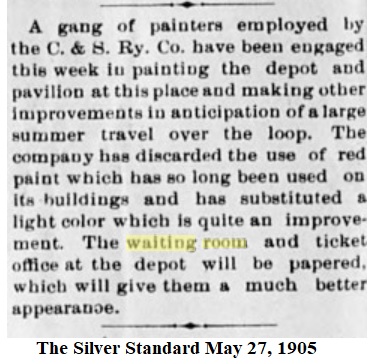 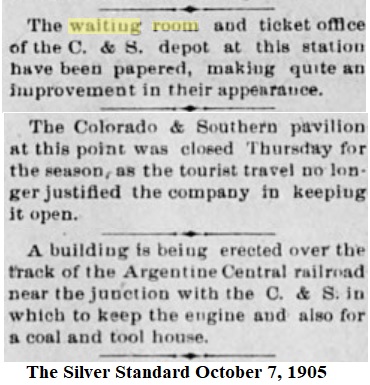 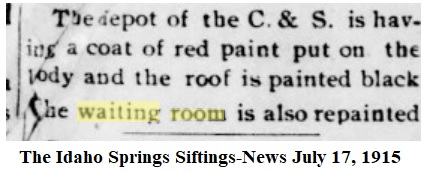 by just placing the pieces together in the Idaho Springs jig-saw we can start to date some items. On pg304 of Colorado Central by Abbott/McCoy/McLeod shows the first I.S. Tank just past the Newhouse Tunnel fresh in the light colour Scheme. Also seen here in this shot showing the Anderson Mill, this is the latest dated picture(so far discovered) showing this tank in place. The Jackson Mill is present in the background making this sometime after 1896, after the construction of the Natatorium and also after the Virginia Canyon flood as well.  From The Idaho Springs Historical Society Coll. This photo of the newly built Bath House shows a Dark Tank, did it revert or was the Light Colour painting of the tank the death knell for it? We often joked that once the Painters showed up on the NZR, the place was closed.  http://digital.denverlibrary.org/cdm/fullbrowser/collection/p15330coll22/id/7133/rv/singleitem 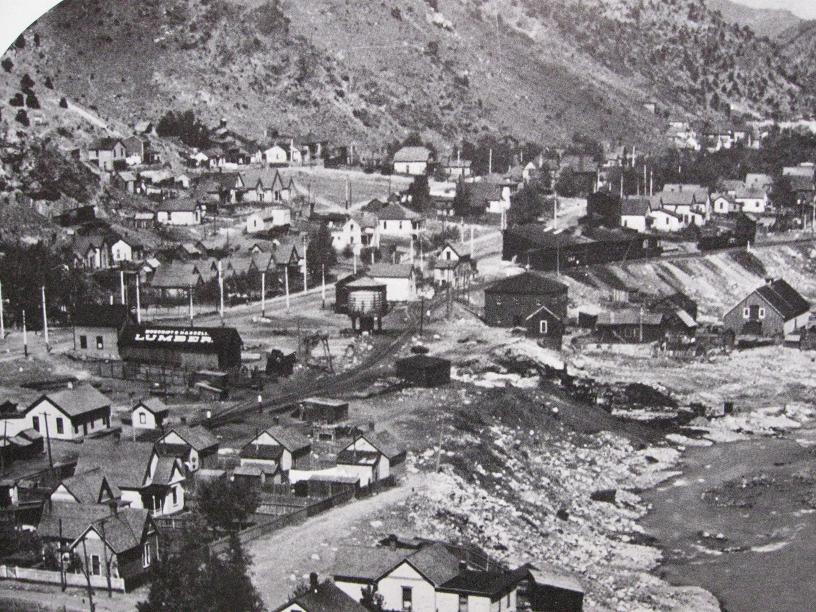 from The Mineral Belt III David S. Digerness pg 314 These views are post (Sanborn Map notation Dec1907) burning of the Bertha/Alpine/Smith Mill.  http://digital.denverlibrary.org/cdm/fullbrowser/collection/p15330coll22/id/1428/rv/singleitem/rec/24 The Idaho Springs 2nd Tank shows up in the background of a number of I.S. pictures that I put up in the Mid-Town Ore Processing parts and also in the Anderson Mill. http://c-sn3-discussion-forum.41377.n7.nabble.com/There-But-Not-Noticed-At-The-Edge-Of-Idaho-Springs-The-Anderson-Mill-td1480.html#a1644 These depending on the date show the Tank in dark and light schemes, see also the I.S. Handcar shed thread. http://c-sn3-discussion-forum.41377.n7.nabble.com/Idaho-Springs-Section-Car-Shed-td3116.html One you missed by far would have to be the twin tanks at Garos that may be outside your "Tourist Line" theory. 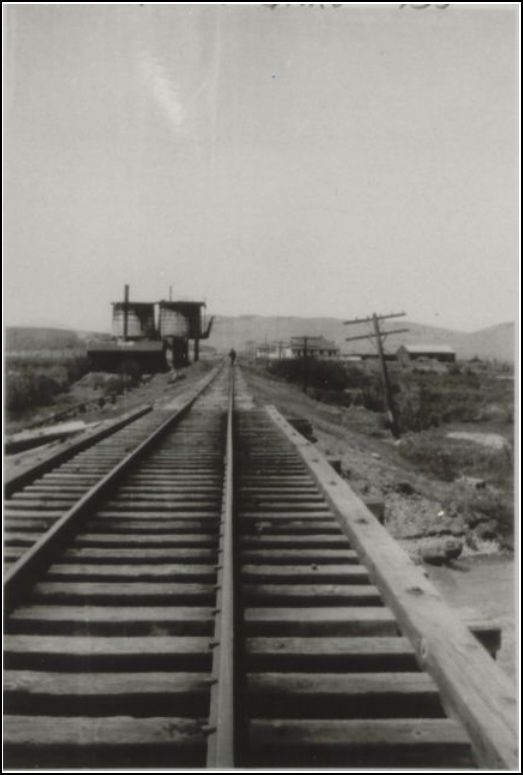 http://www.parkcoarchives.org/
UpSideDownC
in New Zealand |
Re: Early C&S Water Tank Paint Schemes
|
Thanks for the Idaho Springs photos and links, Chris. I knew I'd seen them, just couldn't remember where.
I took the liberty to enlarge and crop the c1903 and c1910 photos from your post and inserted them as an update to the original post above. I think they make a good "before and after" example to illustrate the change in color schemes. I must admit to being uneasy calling this the gray and green scheme; maybe I should stick to "light/dark trim scheme". But there is the 1908 reference in the Como newspaper. Besides, it's relatively simple for last decade modelers to paint a C&S water tank--just spray the whole thing C&S red. But if I have to build a couple of 1908 water tanks, I've got to figure out what to paint the darn things. 
Jim Courtney
Poulsbo, WA |
Re: Early C&S Water Tank Paint Schemes
|
Hi Jim,
While I’ve come up with various theories to other questions, in the end I usually get cold feet and go with Occam’s Razor (make no assumptions beyond what is necessary). I think that would boil down to: 1) If you have documentary evidence (paint chips, colour photo, word-of-mouth), paint it that colour. 2) Else, if you just have a light/dark B&W photo, paint it grey/green. 3) Else, paint it boxcar red. Cheers, Jeff. |
Re: Early C&S Water Tank Paint Schemes
|
In reply to this post by Jim Courtney
Jim,
this picture MCC-1256 http://digital.denverlibrary.org/cdm/fullbrowser/collection/p15330coll22/id/1428/rv/singleitem/rec/24 reproduced above could be your answer. The Jackson Mill opened in 1896 but didn't appear until 1900 on the internet available Sanborn Fire Ins Maps at Boulder Uni. These may have been every year or every five years, I don't know. The last internet available maps for I.S. are dated Dec1907. Looking at MCC-1256 the W.T. is Light so is the Depot. Photos showing the Alpine/Smith Mill standing show a Dark painted Tank. All the Mill elements in MCC-1256 and such as the Strohele Boiler Works, the Mine Supply storage building all show on the 1908 Sanborn. Derrell has written elsewhere the Block C&S is late 1906 onwards and those are present as well. I don't see a way of being able to date this picture any closer, does anyone reading this know the construction date of the I.S. Machine and Boiler Works? X-2271 http://digital.denverlibrary.org/cdm/fullbrowser/collection/p15330coll22/id/3292/rv/singleitem shows both the Bertha #1/Anderson Mill, the Natatorium and the westernmost Bertha/Alpine/Smith Mill along with a Dark Tank. If the 1st W.T. opposite the Ocean Bath-House(later Lumber Yard) was shown as Light coloured in the Sundance, Colorado Central Rail Road whilst the Ocean Bath was still operating yet was visible in Darkpaint behind the new Natatorium, both Tanks must have existed at the same time and in Dark paint to boot.
UpSideDownC
in New Zealand |
Re: Early C&S Water Tank Paint Schemes
|
Chris and Jeff, thanks for your insights.
Chris, the 2 photos you cite indeed clarify the dating: X-2271 certainly predates the other. The boxcars (one by the mill and a couple by the dark depot) both carry the pattern of "the Colorado Road" scheme, so are at least early C&S (post-1901). MCC-1256 is likely post 1907. Derrell has pointed out that the C&S block monogram was adopted as a standard in 1906, but probably wasn't commonly applied until the delivery of the ASF boxcars (8067-8102) in June, 1907 and the Bettendorf (Phase 2) coal cars (4408-4497) delivered between November 1907 and September 1908. This photo shows light paint scheme on depot, water tanks and section house/shed in distance. The boxcars at the depot carry the block monogram as do several coal cars in the string of cars by the mill to the right of the frame. Some of the coal cars show stake patterns c/w the Peninsular 30' cars, some 1898 St Charles cars and others likely 1902 ASF cars, without the block lettering (though the coal car at the far right appears to be a Peninsular car with the block lettering). All of this would suggest post-1907 as a date, probably a bit later. Since this is a McClure negative and he did most of his work for the C&S in 1909-1910, I'm betting that the date of the latter photo is 1909-1910; the McClure photo of Forks Creek at the top this thread is also likely 1909-1910. This would be consistent with the newspaper account of November, 1908, that the Como structures were repainted "gray and green" at that time. So, I guess I will paint my water tank(s) light gray with green bands and trim, unless Rick or Derrell or Doug come up with documents stating they were painted something else.  Jeff, as you pointed out, west of Webster there are may examples of light/dark trim depots and dark/dark water tanks and outbuildings at the same station. In the Klingers' books there are several Carl Reich photos from 19013-14 at Alma Jct. showing a freshly painted light depot with a freshly painted dark tank. Jim
Jim Courtney
Poulsbo, WA |
Re: Early C&S Water Tank Paint Schemes
|
Funny you should mention that, Jim: I finally ordered a couple of the Klingers’ books earlier in the week. Haven’t arrived yet, but I’m looking forward to them…
Cheers, Jeff. |
Re: Early C&S Water Tank Paint Schemes
|
In reply to this post by Jim Courtney
I have updated the original post to include additional photos from Idaho Springs, Silver Plume, Baileys and Grant, hoping to keep the photos in geographical sequence.
Jim Courtney
Poulsbo, WA |
Re: Early C&S Water Tank Paint Schemes
|
This post was updated on .
I've found some more photos that disprove my theory that C&S first decade water tanks and out buildings were painted in the light / dark trim scheme only at stations on the Platte Canon and Clear Creek lines, in order to spruce up the corporate image for the passing excursionists.
I found a McClure photo of Georgetown in Georgetown and the Loop, by Griswold et al, probably from 1908-1912 in which the Georgetown water tank is visible under magnification, and is freshly painted in a dark scheme. I have searched the DPL website in vain for the same photo as a digital image. I did find this McClure photo from roughly the same period, showing (poorly) the dark tank: http://digital.denverlibrary.org/cdm/fullbrowser/collection/p15330coll22/id/75863/rv/singleitem/rec/2 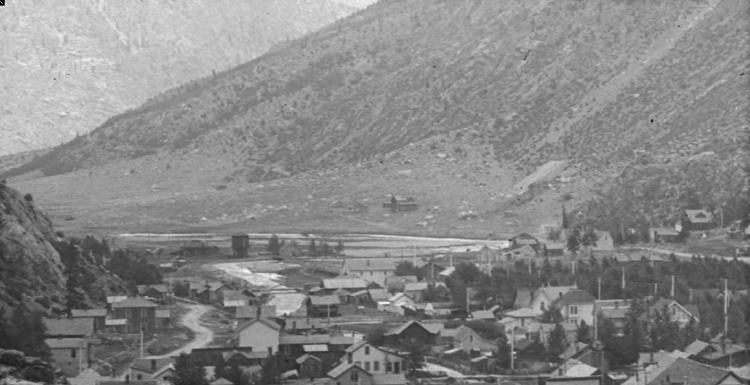 And how did I overlook this one:  This photo from Grandt's (R. Robb) Narrow Gauge Pictorial VII, page 127, makes it obvious that the big 50,000 gallon water tank at Gunnison was also painted in the light / dark (gray / green) scheme. The photo is dated 1910 in the book, but I think Derrell posted somewhere that it was more likely early 1911, after the closure of Alpine Tunnel, before the number 59 and other C&S equipment was moved to Leadville over D&RG rails. So, considering the Gunnison tank and the twin tanks at Garos, it appears the gray / green scheme was more ubiquitous than I had imagined, perhaps a system-wide standard with random exceptions, like Georgetown. I still haven't found photos of light / dark tanks or outbuildings on the Highline over Boreas or Fremont passes. Perhaps Keith will know--was the wood roundhouse at Leadville ever painted in the light / dark trim scheme? And then, there is the question of C&S subsidiaries. During President Trumbull's tenure, the new C&S bought the Gilpin Tram outright and managed to acquire a 50% share of the Colorado Midland, partnering with the Rio Grande Western. On Mark Baldwin's great Gilpin Tram website: http://www.gilpintram.com/index.html , I found this intriquing photo of Gilpin number 5 taking water at the Eureka Street tank:  The photo is undated, but sometime after 1904 when the old tank was replaced by this new structure, during the C&S ownership. What do ya'll think? Gray and green on the Gilpin?? As to the Colorado Midland during the C&S ownership years, I have perused my CM books but not found a light colored water tank in photos. But this remains a question that only a full audit of the Colorado Midland water tanks and outbuildings would answer. How about it "CM Auditor"??
Jim Courtney
Poulsbo, WA |
Re: Early C&S Water Tank Paint Schemes
|
Does anyone know if the AC Water Tank at Argentine Falls painted in the Light Colour was due to the C&S influence, given the connection?
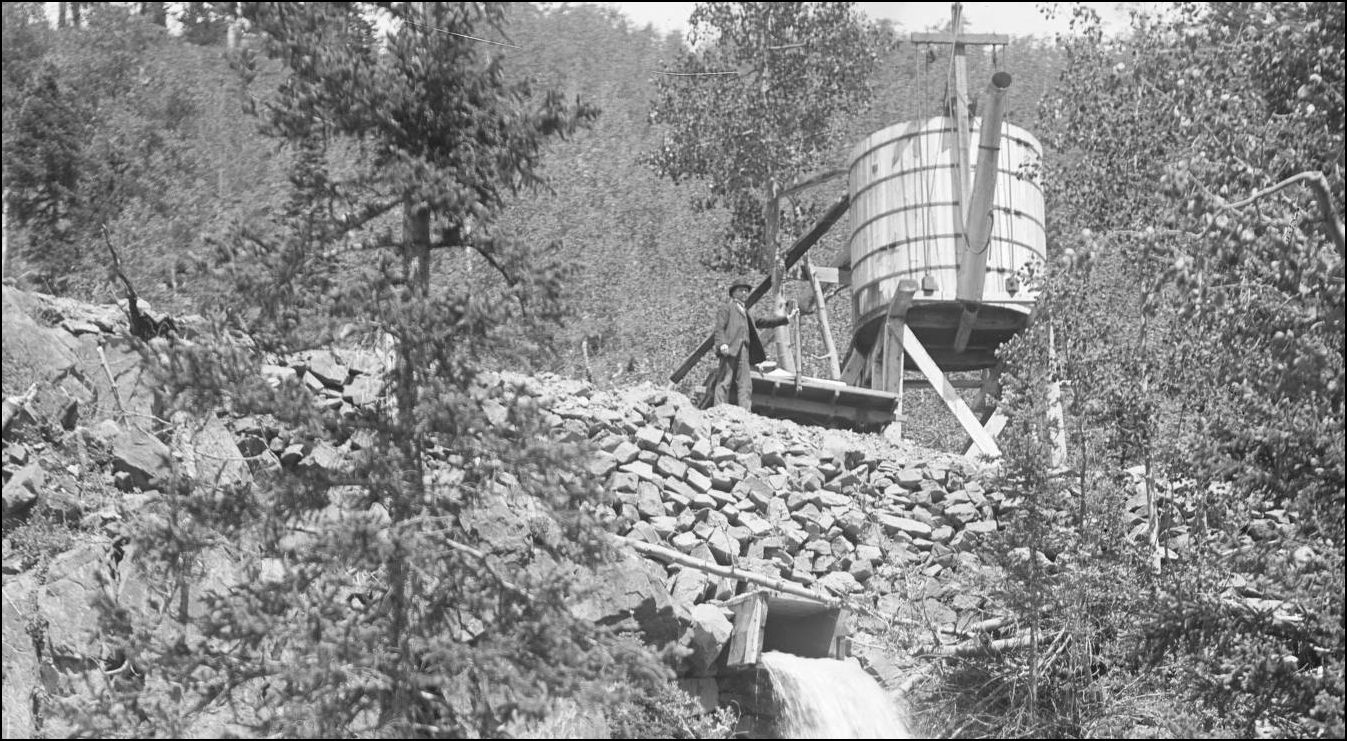 http://cdm16079.contentdm.oclc.org/cdm/fullbrowser/collection/p15330coll22/id/77447/rv/singleitem/rec/30 I figured Jeff would enjoy the Box Culvert prominently shown.
UpSideDownC
in New Zealand |
Re: Early C&S Water Tank Paint Schemes
|
In reply to this post by Jeff Young
A dark Jefferson….

Doug Heitkamp
Centennial, CO |
Re: Early C&S Water Tank Paint Schemes
|
And yet another dog as a focal point. No wonder Roper is such a C&S fan -- must be in the canine DNA.
Jim Courtney
Poulsbo, WA |
Re: Early C&S Water Tank Paint Schemes
|
In reply to this post by Jim Courtney
Jim,
We have yet to have a complete audit of the CM water tanks, but what we have found during the CM's 30 years of existence is the the tanks were paint BCR from start to finish. In 1902, when the D&RG started to exert their influence all of the buildings went from Cream and Green trim to BCR. In the early days the CM used paint from the Ute Pass Paint Co. in Colorado City, which like much of the industry along the line was owned by the "Hagerman Group" which used a "Check the Box" letterhead consisting of 18 different companies to include the Colorado Midland Rwy, Grand River Coal & Coke, Ute Pass Paint, Cascade Ice etc. We do know that in the early days, 1891 to 1893 while the Midland was under Santa Fe ownership, but prior to the take over and inclusion of the CM into the ATSF (March 1893 to May 1893). These eighteen companies moved cash and bills between each other as if they were separate operations, i.e., the shops paid the Ute Pass Paint Co. for the paint used in car repair operations. The railway would bill the Ute Pass Paint Co. for transport of the raw minerals from their point of mining to the plant in Colorado City. How this helps, Tom |
Re: Early C&S Water Tank Paint Schemes
|
In reply to this post by Doug Heitkamp
Hi Doug,
Any date associated with that picture (dark Jefferson depot)? Thanks, Jeff. |
Re: Early C&S Water Tank Paint Schemes
|
In reply to this post by Jim Courtney
For what it is worth here are two pictures of the Tunnel Gulch Tank I took last year. The wood parts are painted gray and green, the bands and spout are painted black. I believe they are the same colors used on the telegraph office. According to Ray Rossman those are based on samples taken from the back side of the boarding house when they lifted it up to check on windows.
Ken Martin  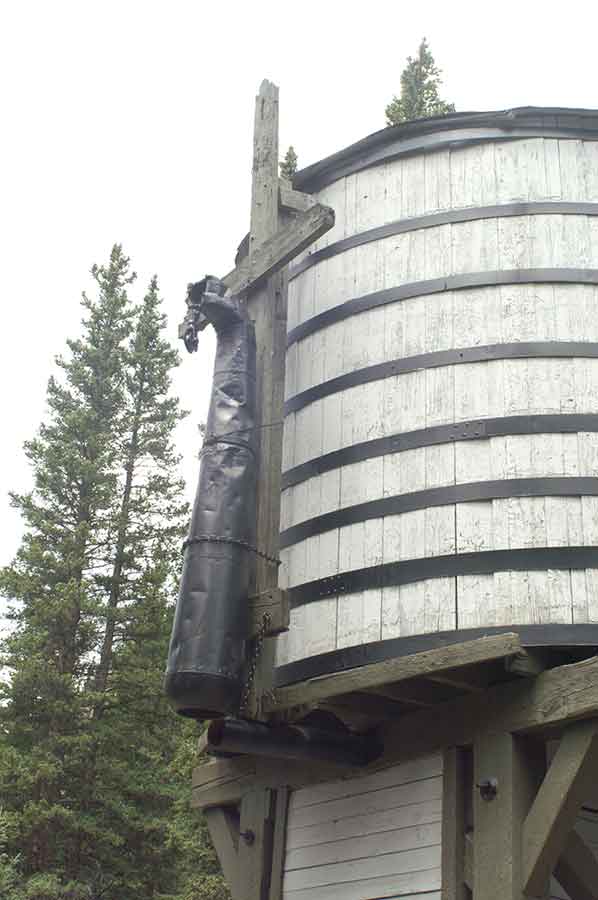 |
Re: Early C&S Water Tank Paint Schemes
|
Huh, never would have guessed the bands and spout were black. (In fact, I never would have guessed the spout was painted at all.)
|
Re: Early C&S Water Tank Paint Schemes
|
In reply to this post by Ken Martin
Thanks for the color photos, Ken.
I helps me envison what the water tanks might look like. Like Jeff, I didn't envision the bands being black, but it kind of makes sense as an alternative to green. Many of the spouts in the period photos look more like unpainted galvanized metal to me. Guess we have to remember that this is a restoration interpretation. Anyone know if metal work was either chemically treated or coated with black substances to prevent rust in the early 1900s? Like the "asphaltium black" paint described on the metal work of the St Charles boxcars? My period water tanks to build seem to keep getting more interesting! Jim
Jim Courtney
Poulsbo, WA |
Re: Early C&S Water Tank Paint Schemes
|
Here's another tank photo from the Detroit Public Library digital collection,
https://digitalcollections.detroitpubliclibrary.org/islandora/object/islandora%3A155129 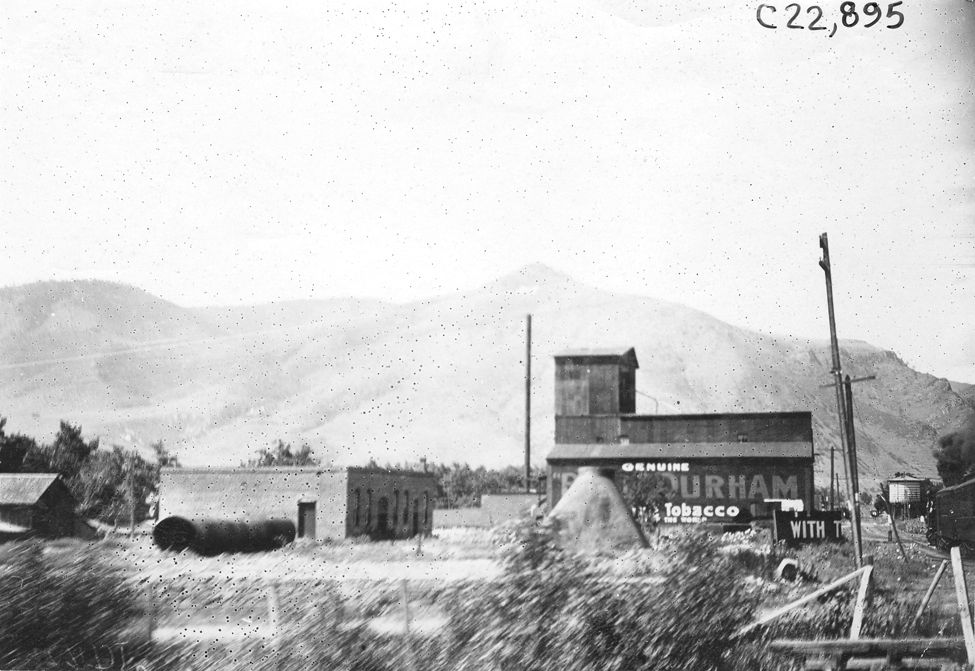 the image ref. number is: EB01g276 here's a crop: 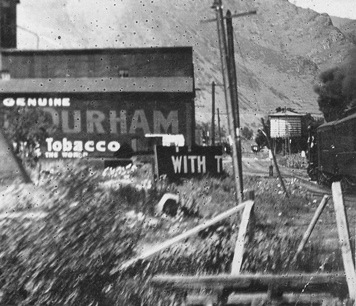 the description says this was taken in 1909, at Golden. Looks like another good candidate for the gray/green scheme? John Greenly Lansing. NY
John Greenly
Lansing, NY |
|
I wonder too. I also would like to know what the date of the photo is. On Feb 18, 2018 6:48 PM, "John Greenly [via C&Sng Discussion Forum]" <[hidden email]> wrote:
Here's another tank photo from the Detroit Public Library digital collection,
Ohio Creek Extension
|
«
Return to C&Sng Discussion Forum
|
1 view|%1 views
| Free forum by Nabble | Edit this page |



